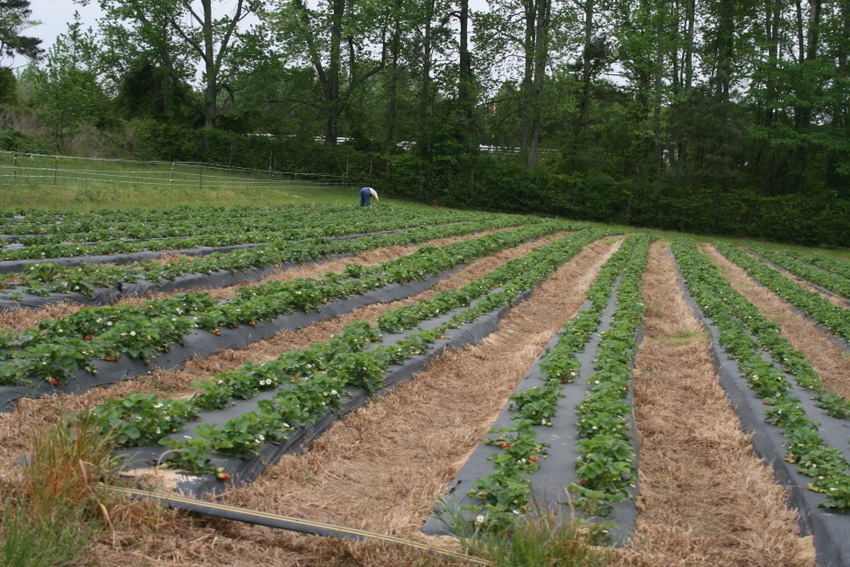May 26, 2014

Fruit and vegetables in the Carolinas suffered some seriously cold weather this winter, including the unexpected cold snap in mid-April, but sources tell Southeast Farm Press that most came through well.
For instance, in the Pee Dee region of South Carolina, fruit crops seemed to be “paying no attention” to the cold weather, said Greg Hyman, owner of Hyman Vineyards of Conway, S.C., on April 22. “Strawberries were a little later than usual. The cold weather in the last week slowed them a little. But now they were making up for lost time.”
But he added that the strawberries he had tasted up to that point had not been real sweet.
Strawberries in the Darlington, S.C., area also were slowed considerably by the cold weather, said Trish DeHond, S.C., area agronomy agent who is stationed in Darlington. “The berries look good and taste good, but they are coming on much later this year,” she said. “We usually start getting them at the end of March, but this season it wasn't until the second or third week of April.”
In central North Carolina, Ronnie Best, market manager of the North Carolina State Farmers Market in Raleigh, said it was a late season because of the cold.
“It had been cold, it got warm, and then on April 16 and 17 it got cold again,” he said. “So the season for strawberries is getting a late start. We have a few now (April 22), mostly from one farm, and we should have more by the end of this week.”
He expected a good supply of berries by May 1, when the market was to hold its annual Strawberry Day.
“It’s been a challenging winter season for strawberry growers, including a record freeze in early January and a late cold snap in April,” said North Carolina Agriculture Commissioner Steve Troxler. “Fortunately, growers used a combination of row covers and irrigation to preserve the crop with minimal loss, and we are set for an outstanding season.”
Several growers in the southeastern part of the state started harvesting in mid-April, but the peak of the season should arrive around the second week of May in the east, said Dexter Hill, marketing specialist with the North Carolina Department of Agriculture and Consumer Services.
Berry supplies should peak in the second and third weeks of May in the Piedmont and from the middle of May through the first half of June in the western part of the state.
That would include the North Carolina mountains, where the mid-April cold snap brought some freeze damage to plants that were leafing out, said Stanley Holloway, Yancey County Extension agent in the USDA crop progress and condition report.
“The strawberry crop was just beginning to bloom, and producers reported that open blossoms were killed,” he said. “But it didn't seem to hurt unopened flowers.” Apples and blueberries in the area were not very far along in bloom at the time, so freeze damage to them was minimal.
Across the Smokies, in Blount County, Tenn., strawberries reportedly sustained damage when temperatures dipped into the Twenties, with some reports of about 25 percent loss of existing blooms.
In central Tennessee north of Nashville, a freeze on the morning of April 6 killed all the unprotected open blooms of strawberries in Sumner County, resulting in an estimated 30 to 40 percent crop loss, said Extension Director Bob Ary. “Strawberries protected with row covers suffered minimal damage,” he said. “Peaches suffered some loss as well.”
In Grundy County, Tenn., near Chattanooga, the Extension Service reported that the cold was so intense that some vegetables in greenhouses were killed by the freeze.
The fruit that may have been most affected by the late cold was peaches. “The blooms may have fallen off from certain varieties,” Best said. “As a result, we may see a gap in the sequence of varieties as they come to the market later.”
Peaches in the Carolinas generally arrive at the market in the order they mature.
Value-added products
Hyman also raises muscadine grapes, tomatoes and squash and sells them--along with produce he obtains from neighbors--at a stand at the Pee Dee State Farmers Market in nearby Florence. He was glad that foot traffic at the market was picking up in April.
“The business in January and February was extremely slow compared to past years, but that was when we had the cold weather. It has improved considerably since then. The customers came with the weather.”
His muscadines, he said, had “broken bud” already and there was no visible damage from the cold. One surprising note: He pruned relatively early in the year, which brings on bud breaking. But he noticed that on some neighboring vineyards that had been pruned much later than his were just as far along in bud development as his.
Value-added products continue to be a very valuable addition to marketing at farmers markets, and the search is on for new products with appeal.
“This year we have added some specialty sauces and marinades,” said Hyman. “Most of them come from old family recipes. These are seasonal products that provide something to sell over the winter.”
He already had products like jams, jellies, ciders and pickles.
In other fruit and vegetable developments, “Mummy” blueberries began to show up in North Carolina in March, said Bill Cline, North Carolina State University Extension plant pathologist. Mummy berries are caused by a fungal disease which turns the fruit pink or salmon. It doesn’t appear every year but was found in 2013.
About the Author(s)
You May Also Like




